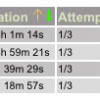Search Exchange
Search All Sites
Nagios Live Webinars
Let our experts show you how Nagios can help your organization.Login
Directory Tree
BRU Server Daemon Monitor
Current Version
1.0.1
Last Release Date
2011-07-05
Compatible With
- Nagios 3.x
Owner
License
Other
Hits
97246
Files:
| File | Description |
|---|---|
| README | README |
Meet The New Nagios Core Services Platform
Built on over 25 years of monitoring experience, the Nagios Core Services Platform provides insightful monitoring dashboards, time-saving monitoring wizards, and unmatched ease of use. Use it for free indefinitely.
Monitoring Made Magically Better
- Nagios Core on Overdrive
- Powerful Monitoring Dashboards
- Time-Saving Configuration Wizards
- Open Source Powered Monitoring On Steroids
- And So Much More!
UPDATED JULY 5, 2011 - Version 1.0.1:
- Fixed a bug that prevented the proper 'critical' status from being displayed when a port was found to be closed.
- Added the plugin version to the 'Status Information' field.
INSTALLATION
------------------------------------------------------------------------------
The installation of this plugin is faily straight forward since it's about
the same as with any other Nagios plugin.
1. Copy the 'check_bruserver' file into your Nagios plugin directory. Some
installations have this at /usr/lib/nagios/plugins and other installations
use the default /usr/local/nagios/plugins.
2. Add the command definition, shown below, to the commands.cfg file.
3. Add the service definitions for the Agent systems. A sample service
definition is shown below in the "Example Service Definitions" section.
4. Add the service definition for the Server system. A sample service
definition is shown below in the "Example Command Definitions" section.
5. Check with Nagios to verify that the changes made are all valid. You can do
this by running the following command:
nagios -v
Some installations have the config file located at /etc/nagios/nagios.cfg
and others have it at the default /usr/local/nagios/etc/nagios.cfg. Use
the appropriate path for your Nagios installation.
If there are no errors, proceed to the next step. Otherwise, you'll need to
correct any errors reported before restarting Nagios.
6. For Nagios installations that do not use xinitd, you'll need to manually
restart the Nagios process for the changes to take affect.
------------------------------------------------------------------------------
The installation of this plugin is faily straight forward since it's about
the same as with any other Nagios plugin.
1. Copy the 'check_bruserver' file into your Nagios plugin directory. Some
installations have this at /usr/lib/nagios/plugins and other installations
use the default /usr/local/nagios/plugins.
2. Add the command definition, shown below, to the commands.cfg file.
3. Add the service definitions for the Agent systems. A sample service
definition is shown below in the "Example Service Definitions" section.
4. Add the service definition for the Server system. A sample service
definition is shown below in the "Example Command Definitions" section.
5. Check with Nagios to verify that the changes made are all valid. You can do
this by running the following command:
nagios -v
Some installations have the config file located at /etc/nagios/nagios.cfg
and others have it at the default /usr/local/nagios/etc/nagios.cfg. Use
the appropriate path for your Nagios installation.
If there are no errors, proceed to the next step. Otherwise, you'll need to
correct any errors reported before restarting Nagios.
6. For Nagios installations that do not use xinitd, you'll need to manually
restart the Nagios process for the changes to take affect.
Reviews (0)
Be the first to review this listing!


 New Listings
New Listings
